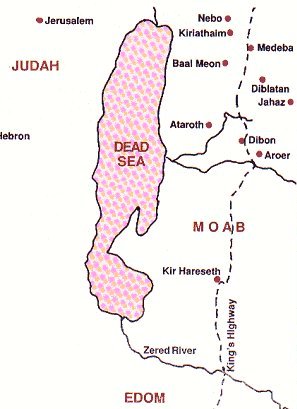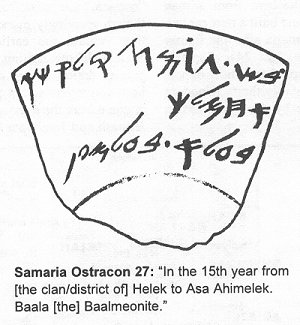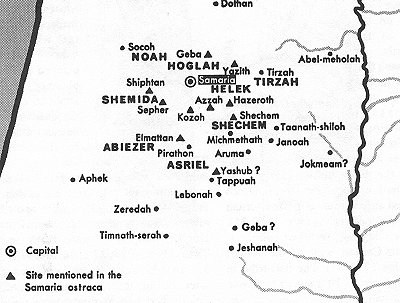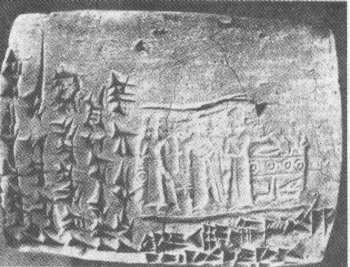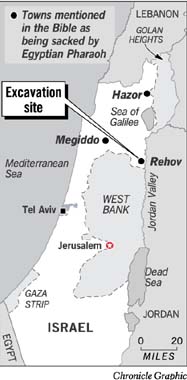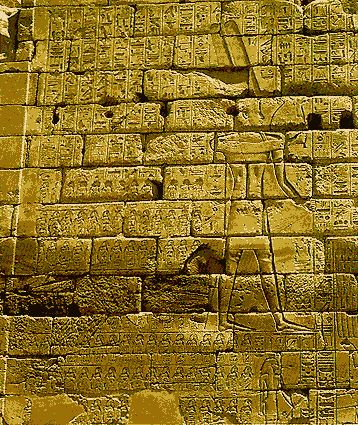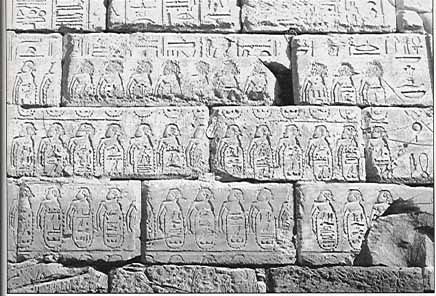Biblical Archaeology Evidences for
the Accuracy of the Scriptures
THE MOABITE STONE
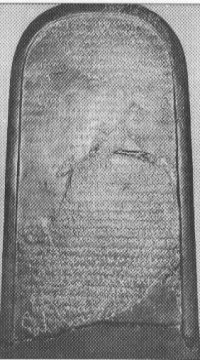
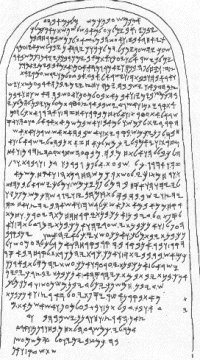
Discovered in Dhiban, Jordan, in 1868 by a Anglican medical missionary by the name of F. A. Klein. The language is Moabite. The translation is by A. Lemaire in 1994. The following is a list of some of the people, places and things that the tablet has in common with the Scriptures.
"I am Mesha ... the Dibonite" (line 1)
Mesha- Genesis 10:30 2Kings 3:4 ; a Moabite king ~853 BC
Dibon- Numbers 21:30 ; a city"Omri had taken posession of the land of Medeba" (line 7)
Omri- 1Kings 16:16 ; king of Israel (the Northern Kingdom) 885-873 BC
Medeba- Numbers 21:30 ; a city"And I built Baal Meon .... And I built Kiriathaim" (lines 9-10)
Beth Ball Meon- Joshua 13:7 Ezekiel 25:9 ; a city and Baal was a Cannanite fertility god
Kiriathaim- Joshua 13:19 Ezekiel 25:9 ; a city"the men of Gad had dwelt in the land of Ataroth from of old, and the king of Israel built Ataroth for himself," (line 10)
Gad- Genesis 30:11 ; a person/tribe/territory
Israel- Genesis 32:28 ; a person/nation/territory (mentioned 4 times)
Ataroth- Numbers 32:3 ; & 32:4 ; a city"the town belonged to Chemosh and to Moab ... Kerioth my town" (line 12)
Chemosh- Numbers 21:9 ; a Moabite god (mentioned 11 times)
Moab- Genesis 19:37 ; a person/tribe/territory
Kerioth- Joshua 15:25 ; a city"men of Sharon ... take Nebo against Israel" (line 14)
Sharon- 1 Chronicles 5:16 ; a plain
Nebo- Numbers 32:3 ; a city"the king of Israel had built Jahaz" (line 18-19)
Jahaz- Numbers 21:23 ; a city"I built Aroer, and made the highway through the Arnon" (line 26)
Aroer- Numbers 32:24 ; a city
Arnon- Numbers 21:13 ; a river"I built Bezer, for it was in ruins" (line 27)
Bezer- Deuternomy 4:43 ; a city, location uncertain."And the house [of Dav]id dwelt in Horanaim" (line 31)
The translation of the above line is uncertain due to the condition of the tablet and is in dispute.
(ref: B&S Vol.9, No.2, Spring 1996)
Biblical Archaeology evidences for the accuracy of the Scriptures.
Samaria Ostraca identifying Clans of Manasseh
Evidence for the locations of the clans of Manasseh, son of Joseph, were discovered in 1910 under the direction of G. A. Reisner in Samaria ( the capital city established 880 BC by king Omri ). Discovered were 63 potsherds with inscriptions written in ink, called ostraca ( plural ) or ostracon (singular). Though seemingly a minor find, they remain among the earliest of the archaeological discoveries of ancient Hebrew writings. Commercial records that document the transaction of oil and wine from various regions of Samaria to various officials. Thirty of them identify the clan/district name of 7 of the 10 offspring of Manasseh identified in Joshua 17:2-3 when they were being assigned their territory in chapter 17. Each of the five sons of verse 2 are identified, Abiezer ( 1 ostracon), Asriel ( 2 ostraca ), Helek ( 6 ostraca ), Shechem ( 1 ostracon ), and Shemida ( 17 ostraca ). Only two of the daughters of Zelophehad (verse 17:3) are identified, Hoglah ( 2 ostraca ) and Noah ( 1 ostracon ). The potsherds are estimated to date approximately 784-783 BC. The allocation of the territories took place in the 15th century BC and one might suspect that clan designations could have possibly passed out of use by that time. However, the locations and the spellings are unchanged. An indication of the strength of the clan loyalty of the nomadic Israelite tribes and a testimony to the accuracy of the Biblical records.
(ref. B&S Vol 10, No. 1, Winter 1997)Biblical Archaeology evidences for the accuracy of the Scriptures.
Customs and laws of Nuzi
A library of tablets dating from 1600 to 1350 BC was located at Nuzi, an ancient trade center in Assyria. The site possibly had been settled since 3000 BC and was first called Gasur. Among the more interesting discoveries in the tablets were some of the social and religious practices of the periods as recorded in the deeds, wills, marriage agreements, and adoptions. They possibly shed light on many of the customs that are documented in the Scriptures that may appear to us as being unusual (wierd?).
In the case of a childless couple, the wife could locate another wife for the husband.
"If Gilimninu (the wife) will not bear children, Sarah provided Hagar for Abraham (Genesis 16:3) for the purposes of bearing children. Should the first wife later bear a son, he would rank over a son born to the second wife. Such was the case when Isaac was born (Genesis 21:1-10)
Gilimninu shall take a woman of Lulluland as a wife for Shennma (the husband)."Adoptions were used, a man could adopt a woman as a sister and he agreed to provide a husband for the woman, and a childless couple could adopt a slave or a man lacking property. Possibly applying to the relationship of Abraham to Sarah (Genesis 20:2) and also that of Eliezer (Genesis 15:2) in Abraham's household. The adopted person was obligated to care for the needs, weep over and bury them when they died.
Fathers were not required to select the first born son as the heir, the could select any of the sons as they so pleased. Example Jacob's selection of Joseph and then passing this right of inheritance onto the sons of Joseph, Ephriam and Manasseh as though they were his sons. (Genesis 48:5)
A father was required to find a wife for the sons (Genesis 24:4) and arrange marriage contracts for the daughters. If the parents died, the heir was required to arrange the marriage of his sisters. But in this case the heir had less authority and the sister had the right of refusal.
Wills referred to the family gods as symbols of ownership and authority and were highly valued. Possibly explaining why Laban was so concerned that Rachel had taken the images when Jacob was fleeing Laban (Genesis 31). Tablets were also highly valued and passed down from generation to generation.
Also there were tablets documenting that a heir could legally sell their birthright to a brother. Example, Esau exchanging his birthright for soup in a time of need (Genesis 25:29-34).
Also found were tablets recording blessings pronounced by aging men just before an expected death. As did Jacob in Genesis 48-49, Moses in Deuteronomy 33 and Joshua in Joshua 23-24.
Therefore, many of the recorded customs in Genesis are demonstrated to be consistent with the customs of the ancient mideast societies.
(ref. B&S vol. 7, No. 1, Winter 1994)
C14 dating affirms Scripture/Scripture affirms C14 dating!
San Francisco Chronicle
A judgment about Solomon
Evidence supports Hebrew kingdoms in biblical timesDavid Perlman, Chronicle Science Editor
Deep in the ruins of a Hebrew town sacked nearly 3,000 years ago by an Egyptian Pharaoh, scientists say they have discovered new evidence for the real-life existence of the Bible's legendary kingdoms of David and Solomon.
The evidence refutes recent claims by other researchers who insist that the biblical monarchs were merely mythic characters, created by scholars and scribes of antiquity who made up the tales long after the events to buttress their own morality lessons.
The debate, however, is not likely to subside, for archaeology is a field notable for its lengthy quarrels among partisans, however scientific they may be.
The latest evidence comes from Israeli and Dutch archaeologists and physicists after seven years of digging at a historic site called Tel Rehov. The site is in the Jordan valley of Israel, where successive settlements rose and fell over the centuries.
Using highly sophisticated techniques for establishing dates through the decay rate of radioactive carbon, the scientists have pinned down the time of a disputed moment in history, recorded in the Bible, when a Pharaoh now known as Shoshenq I invaded Jerusalem.
As the book of Chronicles relates in the Old Testament, Shoshenq (the Bible called him Shishak) came "with twelve hundred chariots and threescore thousand horsemen" and plundered Israel's capital, as well as such towns and fortresses as Rehov, Megiddo and Hazor.
The Pharaoh later listed those conquests on a monument in the temple of Amun at Karnak, where the Egyptian city of Luxor now stands.
11=Gaza, Genesis 10:19, Joshua 10:41 12=Makkedah, Joshua 10:10
13=Rubuti,
14=Aijalon, Joshua 21:24
15=Kiriathaim?,
16=Beth- horon, Joshua 10:10
17=Gibeon, Joshua 9:3
18=Mahanaim, Genesis 32:2, Joshua13:26
19=Shaud[y],
20=?,
21=Adoraim, 2 Chronicles 11:9
22=Hapharaim, Joshua 19:9
23=Rehob, Numbers 13:21, Joshua 19:28
24=Betshan,
25= Shunem, Joshua 19:18
26=Taanach, Joshua 12:21
27=Megiddo, Joshua 12:21
28=Adar, Joshua 15:3
29=Yadhamelek,
(List and second photo from http://www.specialtyinterests.net/sheshonk.html)
The new timetable places Shoshenq's rampage and looting at Rehov in the 10th century rather than the 9th, a highly significant difference. It sets the date at about 925 B.C., some five years after Solomon was said to have died, and some 80 years earlier than other archaeologists maintain.
Those scholars, known in the world of archaeology as "minimalists," insist that both David and Solomon were little more than tribal chieftains, and certainly not the mighty monarchs of the Bible.
A report on the new evidence appears today in the journal Science by Hendrik Bruins, a desert researcher at Ben-Gurion University of the Negev in Israel, Johannes van der Plicht of the Center for Isotope Research at the University of Groningen in the Netherlands, and Amihai Mazar of the Hebrew University of Jerusalem, the principal archaeologist at Tel Rehov.
In a telephone interview, Mazar said that one specific "layer of destruction" at the site yielded a harvest of charred grain seeds and olive pits that enabled his colleagues to date them with an unusually high level of precision. The dates of both earlier and later layers showed clearly how the successive layers of occupation could be determined from the 12th through the 9th centuries B.C., he said.
"They provide a precise archaeological anchor for the united monarchies of the time of David and Solomon," Mazar said. "The pottery we found there also tells us that the conquest dates from the same period as Meggido, when its mighty gates and walls and temples were also destroyed by Shoshenq's armies."
More than 40 years ago the late Yigael Yadin, who won fame as an army officer during Israel's war for independence, turned to archaeology and after excavating the imposing ruins at Megiddo maintained that they were in fact destroyed during the so-called Solomonic period.
Recently, however, a group of archaeologists led by Israel Finkelstein of Tel Aviv University working at Megiddo has insisted that the so-called Solomon's gate there dates from a much later time -- perhaps 100 or even 200 years after Solomon.
Finkelstein read a copy of the Mazar report that was sent him by e-mail. After replying that Mazar "is a fine scholar," he insisted that "there are many problems with his archaeological data" and that the samples of material used for the radiocarbon dating are at best questionable.
In the past, Finkelstein has accused Mazar of harboring a "sentimental, somewhat romantic approach to the archaeology of the Iron Age," according to an earlier account in Science.
On Thursday, however, one of the leaders in the archaeology of Israel, Professor Lawrence E. Stager, who is director of Harvard University's Semitic Museum, dismissed the claims of Finkelstein and the other archaeologists who share his views.
"Mazar and his colleagues have now put another nail in the coffin of Finkelstein's theories," Stager said. "There's no question that Rehov and the other cities that Shoshenq conquered were indeed there at the time of Solomon.
"We don't need to rely any more only on the Bible or on Shoshenq's inscriptions at Karnak to establish that Solomon and his kingdom really existed, because we now have the superb evidence of the radiocarbon dates."
copied from http://sfgate.com/cgi-bin/article.cgi?f=/c/a/2003/04/11/MN24970.DTL
Radio-dating backs up biblical text
11 September 2003
HELEN R. PILCHER
The 500 meter-long tunnel still carries water to the
city of David© BiblePlaces.com An ancient waterway, described in the Bible, has been located and radiocarbon-dated to around 700 BC1.
The half-kilometre Siloam Tunnel still carries water from the Gihon Spring into Jerusalem's ancient city of David. According to verses in Kings 2 and Chronicles 2 2, it was built during the reign of the King Hezekiah - between 727 BC and 698 BC - to protect the city's water supply against an imminent Assyrian siege. Critics argue that a stone inscription close to the exit dates the tunnel at around 2 BC.
To solve the conundrum, geologist Amos Frumkin, of the Hebrew University of Jerusalem, and colleagues looked at the decay of radioactive elements - such as carbon in plants and thorium in stalactites - in tunnel samples.
The plaster lining the tunnel was laid down around 700 BC, says Frumkin's team. A plant trapped inside the waterproof layer clocked in at 700-800 BC, whereas a stalactite formed around 400 BC. "The plant must have been growing before the tunnel was excavated; the stalactite grew after it was excavated," explains Frumkin.
The study "makes the tunnel's age certain", says archaeologist Henrik Bruins of Ben-Gurion University of the Negev, Israel. The Siloam Tunnel is now the best-dated Iron Age biblical structure so far identified.
The remains of buildings and structures described in the Bible are notoriously difficult to find. Specimens are rare, poorly preserved, hard to identify and often troublesome to access. Says James Jones, Bishop of Liverpool, UK: "This scientific verification of historical details in the Bible challenges those who do no wish to take it seriously."
Tunnel vision
The samples also help to explain how the tunnel was built. The passage is sealed with layers of plaster, the deepest and oldest of which is directly above the bedrock, with no sediment between. This shows that the plaster was applied immediately after the tunnel was built, Frumkin says.
"It's also quite unique to find well-preserved plant remains in plaster," says Bruins. Workers may have made up huge quantities outside the tunnel, where the plants could have become mixed in, and then taken it inside.
Large enough to walk inside, the Siloam Tunnel zigzags through an ancient hill. Its carved inscription describes how two teams of men, starting on opposite sides of the mountain, managed to meet in the middle. They may have followed a natural fissure in the limestone rock, Bruin suggests.
Ben-Gurion UniversityUnusually, the inscription does not name King Hezekiah - other monarchs commonly boasted of their architectural achievements in stone. The carving is six metres inside the tunnel, so it must have been made by lamplight.
"It wasn't meant to be seen by the public," says Biblical historian Andrew Millard of Liverpool University, UK. "I think it was the workmen recording what an extraordinary feat they had accomplished."
- Frumkin, A., Shimron, A. & Rosenbaum, J. Radiometric dating of the Siloam Tunnel, Jerusalem. Nature, 425, 169 - 171, (2003). |Article|
- 2 Kings 20:20; 2 Chronicles 32:3,4.
© Nature News Service / Macmillan Magazines Ltd 2003copied from http://www.nature.com/nsu/030908/030908-9.html
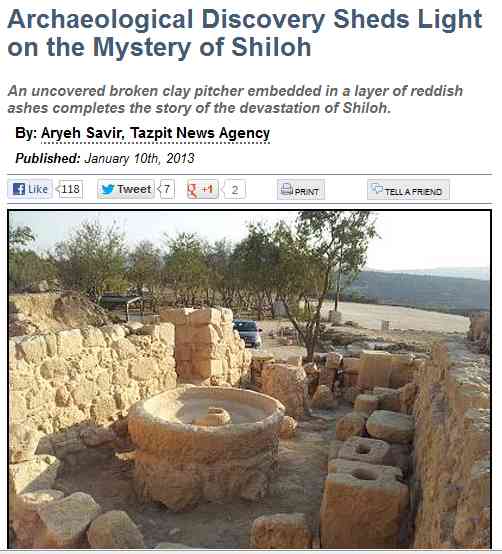
Tel Shiloh (Photo Credit: Tazpit News Agency)
Recent archaeological findings in Samaria shed light on the incomplete story of the destruction of Shiloh, the ancient capital of Israel.
An uncovered broken clay pitcher embedded in a layer of reddish ashes completes the story of the devastation of Shiloh, where the Mishkan, the Tabernacle, was placed during the period of the Judges, and essentially served as Israel’s capital during the early part of the First Israelite commonwealth.
Shiloh served as the spiritual center of Israel for 369 years until its destruction. The Bible does not inform us of the story of its ruin, but these archaeological discoveries shed light on the capital’s tragic demise.
The book of Samuel tells us of a battle between the Philistines and the Israelites, during which the Philistines prevailed, and during which the Holy Ark was captured by them. After hearing the news of the defeat from a messenger, Eli the High Priest, the leader of his time, who lost his two sons in the battle, fell back and died. This is all we learn of the defeat from the Book of Samuel.
We know that Shiloh was destroyed shortly thereafter. We know from the book of Jeremiah that Shiloh was destroyed by the Philistines. These new archaeological findings tell us of how it happened. After the battle, which took place at Even Ha’ezel, near modern day Rosh Ha’ayin, the Philistines moved on to destroy Shiloh, the capital. The ashes found attest to a devastating fire the occurred at the site. The dating of the clay pitcher, 1,050 BCE, correlates with the dating of the events depicted in Book of Samuel.
Avital Selah, director of the Tel Shiloh site, told Tazpit News Agency that these findings were discovered during a massive dig of the Tel Shiloh site, in which some 1000 youth volunteers from across Israel participated. Similar findings were discovered thirty years ago, including food leftovers, and their dating is also set at 1,050 BCE, but the recently discovered layer of ashes completes the story regarding the story of the destruction of the ancient Israelite capital of Shiloh.
from http://www.jewishpress.com/news/breaking-news/archaeological-discovery-sheds-light-on-the-mystery-of-shiloh/2013/01/10/?src=ataglance
Once again archaeology confirms the Bible !
And the Bible confirms archaeological dating methods !
From http://www.latimes.com/news/science/la-sci-siloam 9aug09,1,3097577.story ?coll=la-news-science (edited)
The Pools at Siloam
By Thomas H. Maugh II, Times Staff Writer, August 9, 2005
"Workers repairing a sewage pipe in the Old City of Jerusalem have discovered the biblical Pool of Siloam, a freshwater reservoir that was a major gathering place for ancient Jews making religious pilgrimages to the city.
![[IMAGE]](siloam300_376.jpg)
The pool was fed by the now famous Hezekiah's Tunnel and is "a much grander affair" than archeologists previously believed, with three tiers of stone stairs allowing easy access to the water, said Hershel Shanks, editor of the Biblical Archaeology Review, which reported the find Monday.
The newly discovered pool is less than 200 yards from another Pool of Siloam, this one a reconstruction built between AD 400 and 460 by the Empress Eudocia of Byzantium, who oversaw the rebuilding of several biblical sites.
The site of the first Pool of Siloam constructed in the 8th century BC by Judean King Hezekiah, who foresaw the likelihood that the Assyrians would lay siege to Jerusalem and knew a safe water supply would be required to survive the attack, is still unknown. It was presumably destroyed in 586 BC when Babylonian King Nebuchadnezzar razed the city.
The pool was discovered by a repair team excavating a damaged sewer line last fall under the supervision of Eli Shukron of the Israel Antiquities Authority. As soon as Shukron saw two steps uncovered, he stopped the work and called in Reich, who was excavating at the Gihon Spring.
When they saw the steps, Shukron said, "we were 100% sure it was the Siloam Pool."
With winter approaching, the two men had to hurry their excavation so the sewer could be repaired before the rainy season.
As they began digging they uncovered three groups of five stairs each separated by narrow landings. The pool was about 225 feet long, and they unearthed steps on three sides.
They do not yet know how wide and how deep the pool was because they have not finished the excavation. The fourth side lies under a lush garden — filled with figs, pomegranates, cabbages and other fruits — behind a Greek Orthodox Church, and the team has not yet received permission to cut a trench through the garden.
"We need to know how big it is," Charlesworth said. "This may be the most significant and largest miqveh [ritual bath] ever found."
The excavators have been able to date the pool fairly precisely because of two fortunate occurrences that implanted unique artifacts in the pool area.
When ancient workmen were plastering the steps before facing them with stones, they either accidentally or deliberately buried four coins in the plaster. All four are coins of Alexander Jannaeus, a Jewish king who ruled Jerusalem from 103 to 76 BC. That provides the earliest date at which the pool could have been constructed.
Similarly, in the soil in one corner of the pool, they found about a dozen coins dating from the period of the First Jewish Revolt against Rome, which lasted from AD 66 to 70. That indicates the pool had begun to be filled in by that time.
Because the pool sits at one of the lowest spots in Jerusalem, rains flowing down the valley deposited mud into it each winter. It was no longer being cleaned out, so the pool quickly filled with dirt and disappeared, Shanks said."

Biblical Archaeology evidences for the accuracy of the Scriptures. Biblical archaeology evidences for ancient Semetic presences through out the Middle East that verify the Scriptural records. Including the Moabite stone from Moab Jordan, Samaria Ostraca identifying Clans of Manasseh, and Customs and laws of Nuzi from the Nuzi tablets. Biblical Archaeology Moab Moabite stone Samaria Ostraca Nuzi tablets



 Biblical archaeology evidences for ancient Semetic presences through out the Middle East that verify the Scriptural records. Including the Moabite stone from Moab Jordan, Samaria Ostraca identifying Clans of Manasseh, and Customs and laws of Nuzi from the Nuzi tablets. Biblical Archaeology Moab Moabite stone Samaria Ostraca Nuzi tablets
Biblical archaeology evidences for ancient Semetic presences through out the Middle East that verify the Scriptural records. Including the Moabite stone from Moab Jordan, Samaria Ostraca identifying Clans of Manasseh, and Customs and laws of Nuzi from the Nuzi tablets. Biblical Archaeology Moab Moabite stone Samaria Ostraca Nuzi tablets



 Biblical archaeology evidences for ancient Semetic presences through out the Middle East that verify the Scriptural records. Including the Moabite stone from Moab Jordan, Samaria Ostraca identifying Clans of Manasseh, and Customs and laws of Nuzi from the Nuzi tablets. Biblical Archaeology Moab Moabite stone Samaria Ostraca Nuzi tablets
Biblical archaeology evidences for ancient Semetic presences through out the Middle East that verify the Scriptural records. Including the Moabite stone from Moab Jordan, Samaria Ostraca identifying Clans of Manasseh, and Customs and laws of Nuzi from the Nuzi tablets. Biblical Archaeology Moab Moabite stone Samaria Ostraca Nuzi tablets




